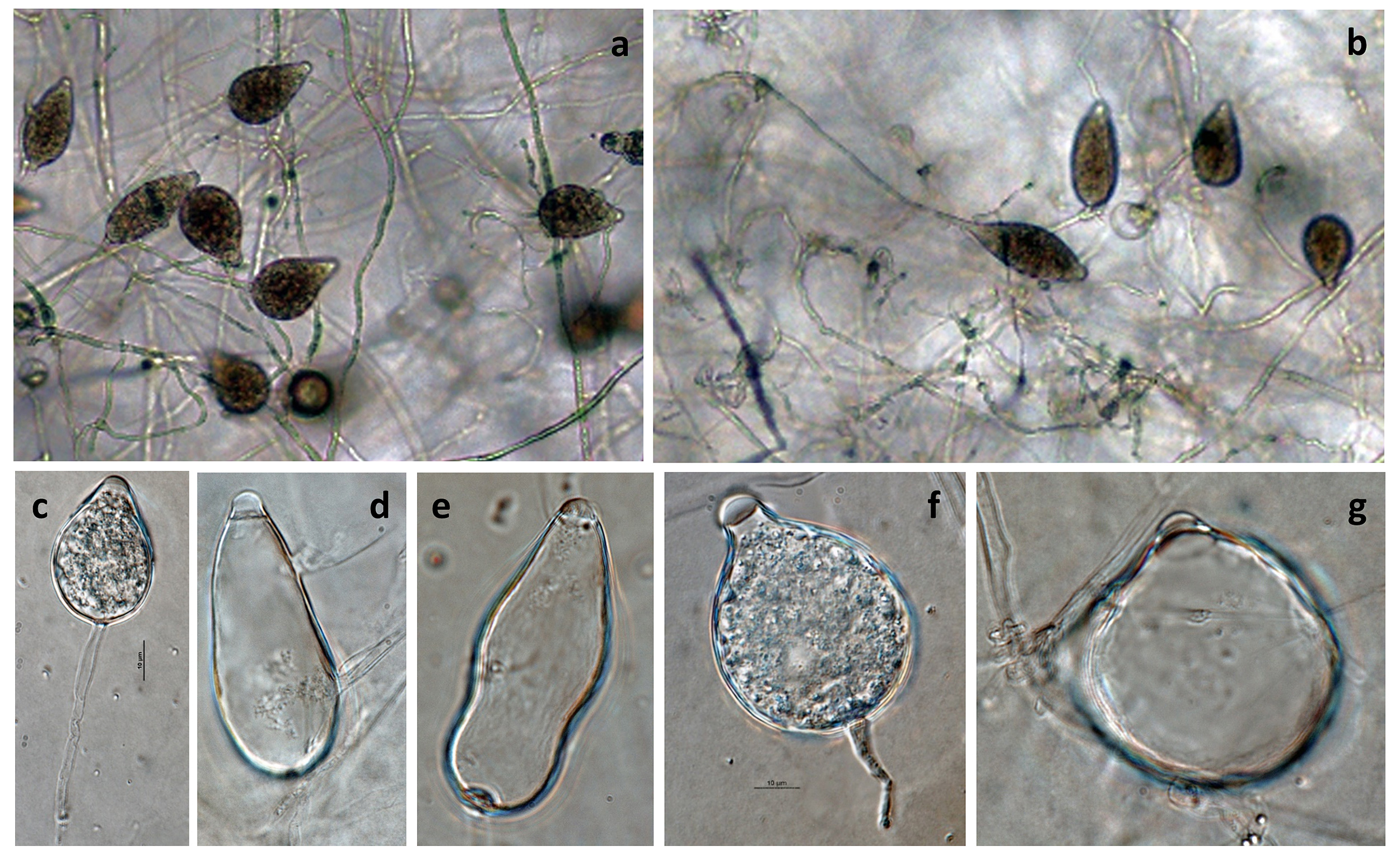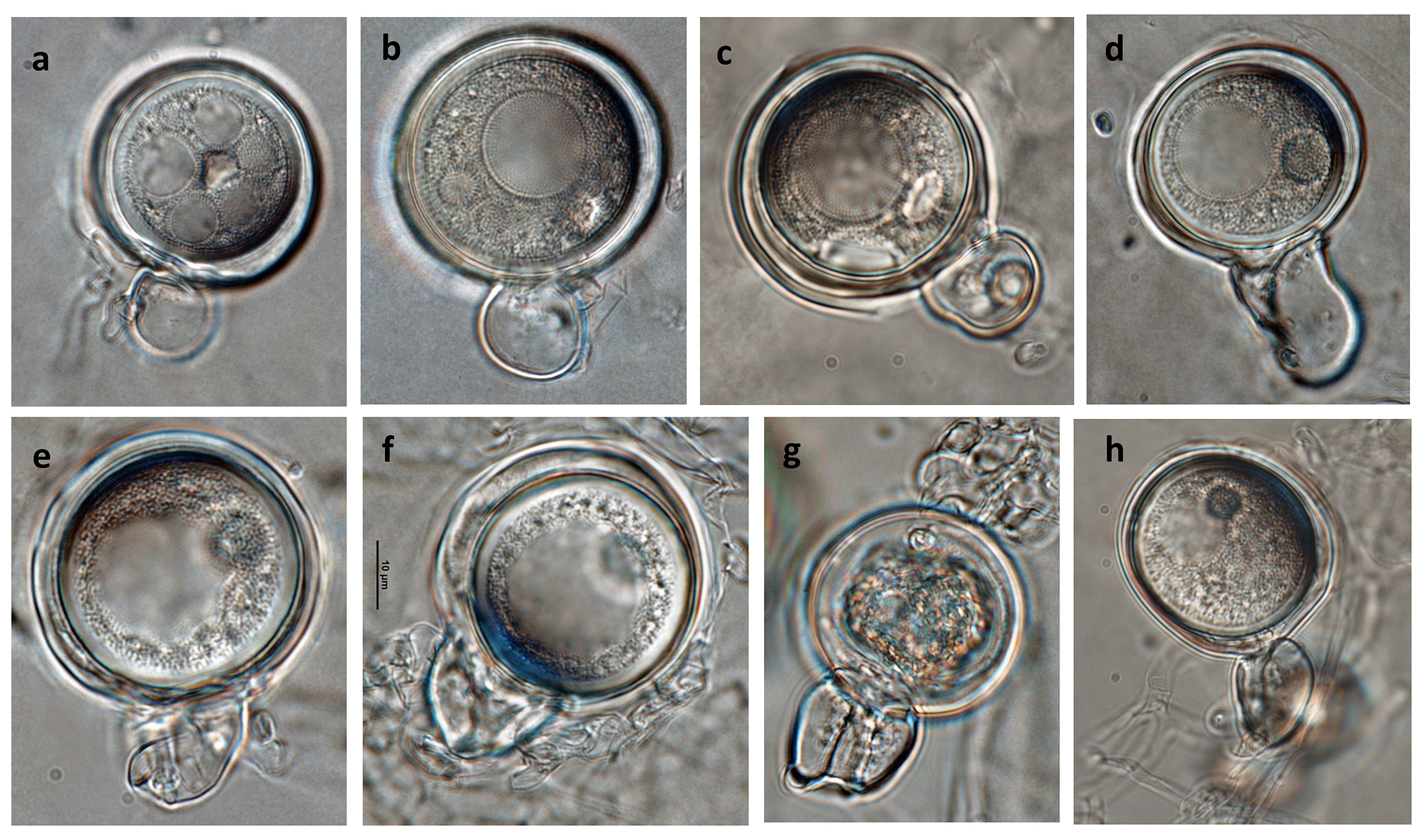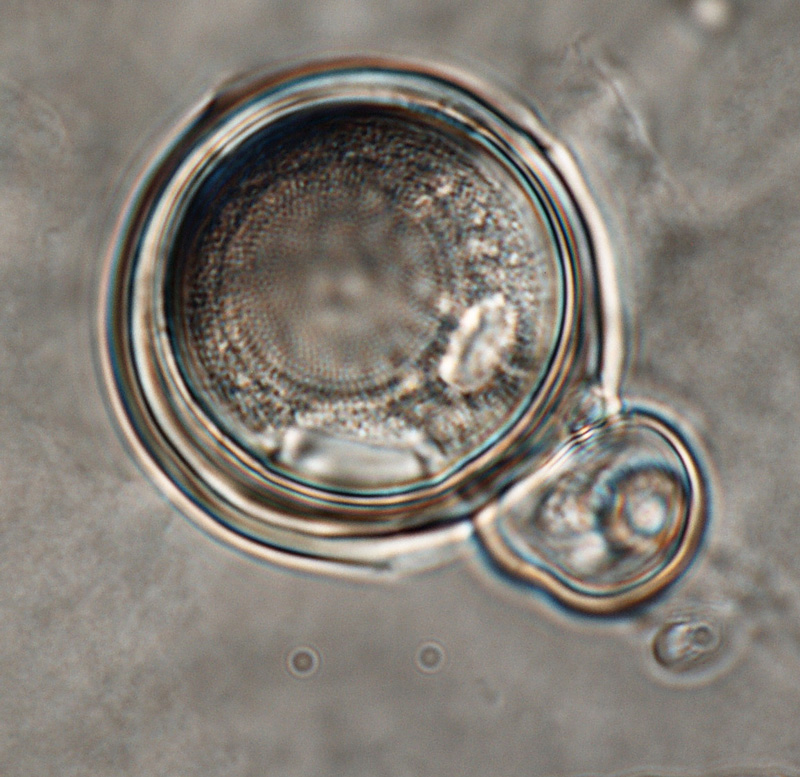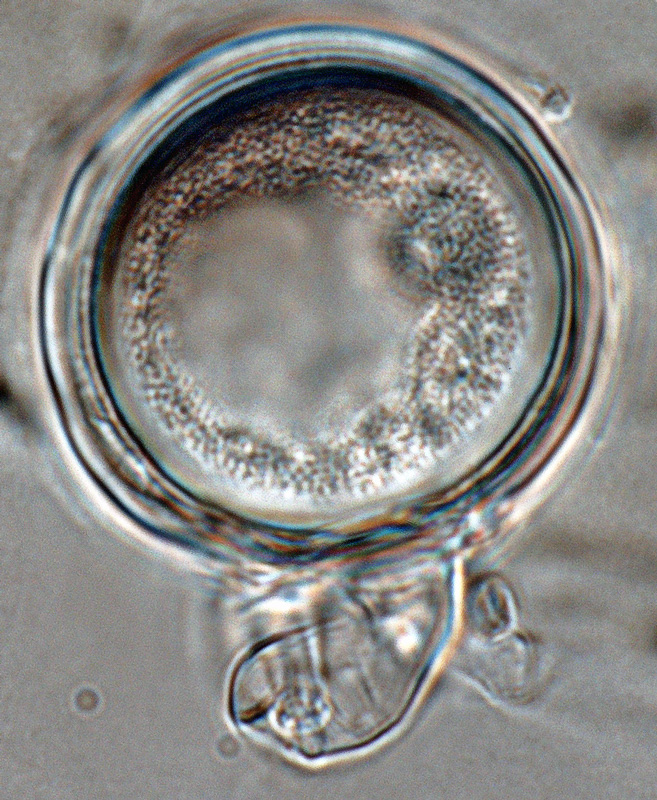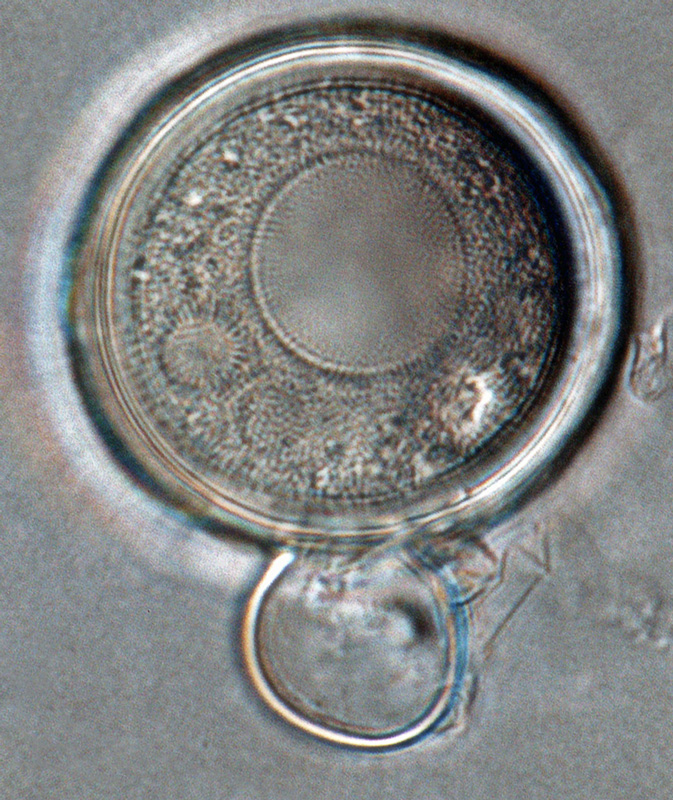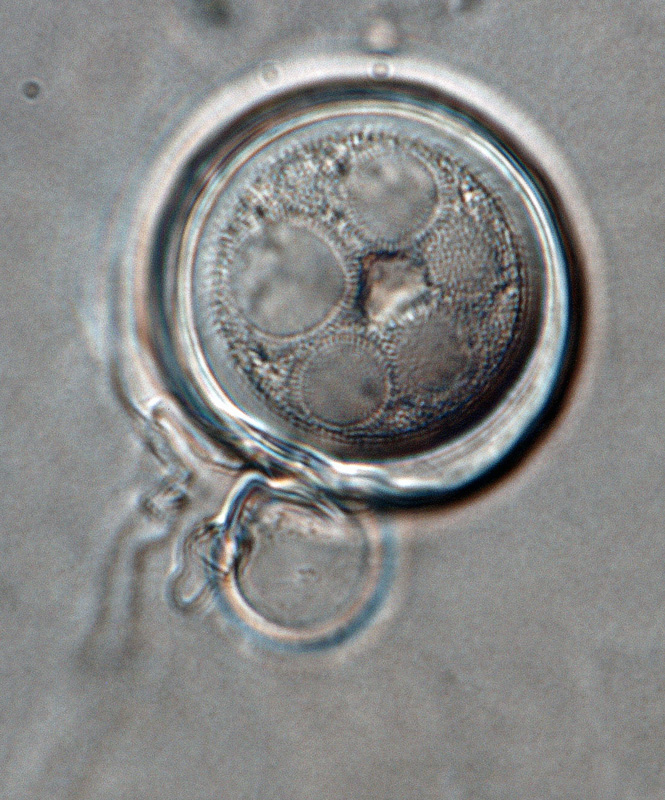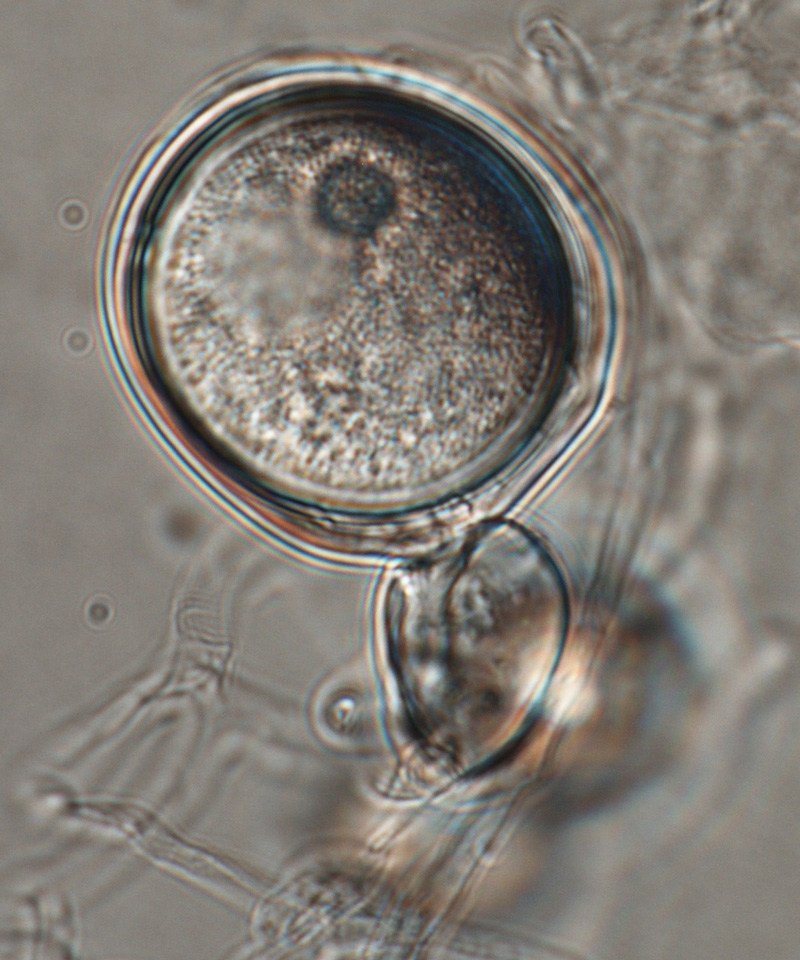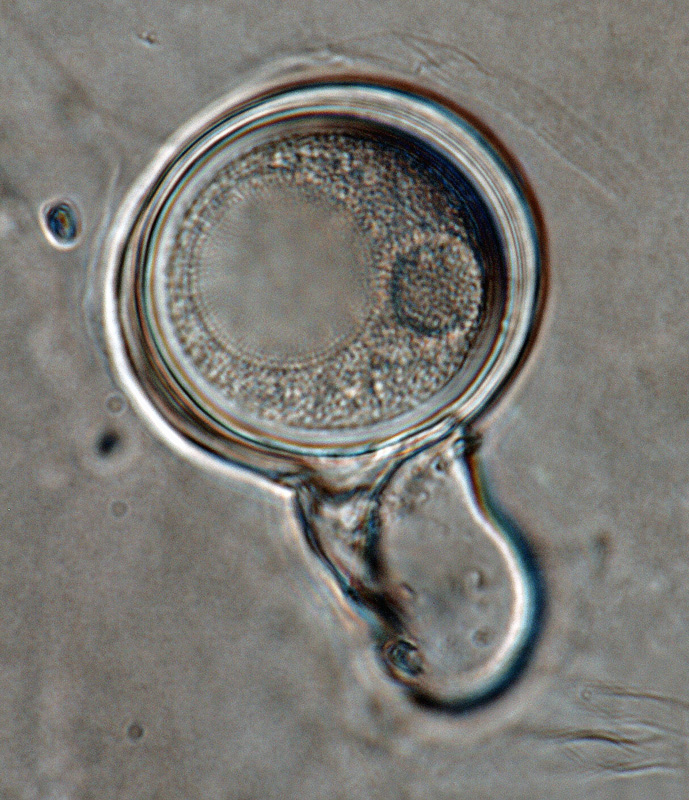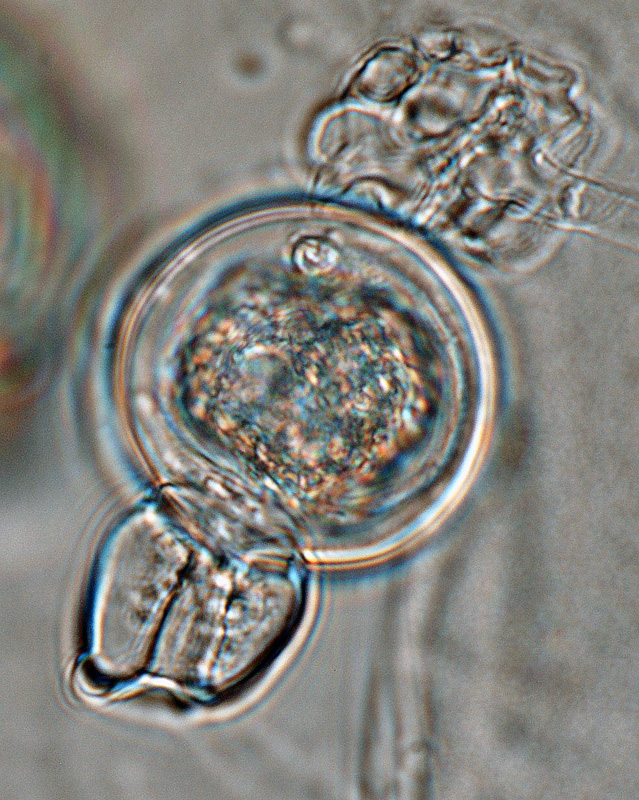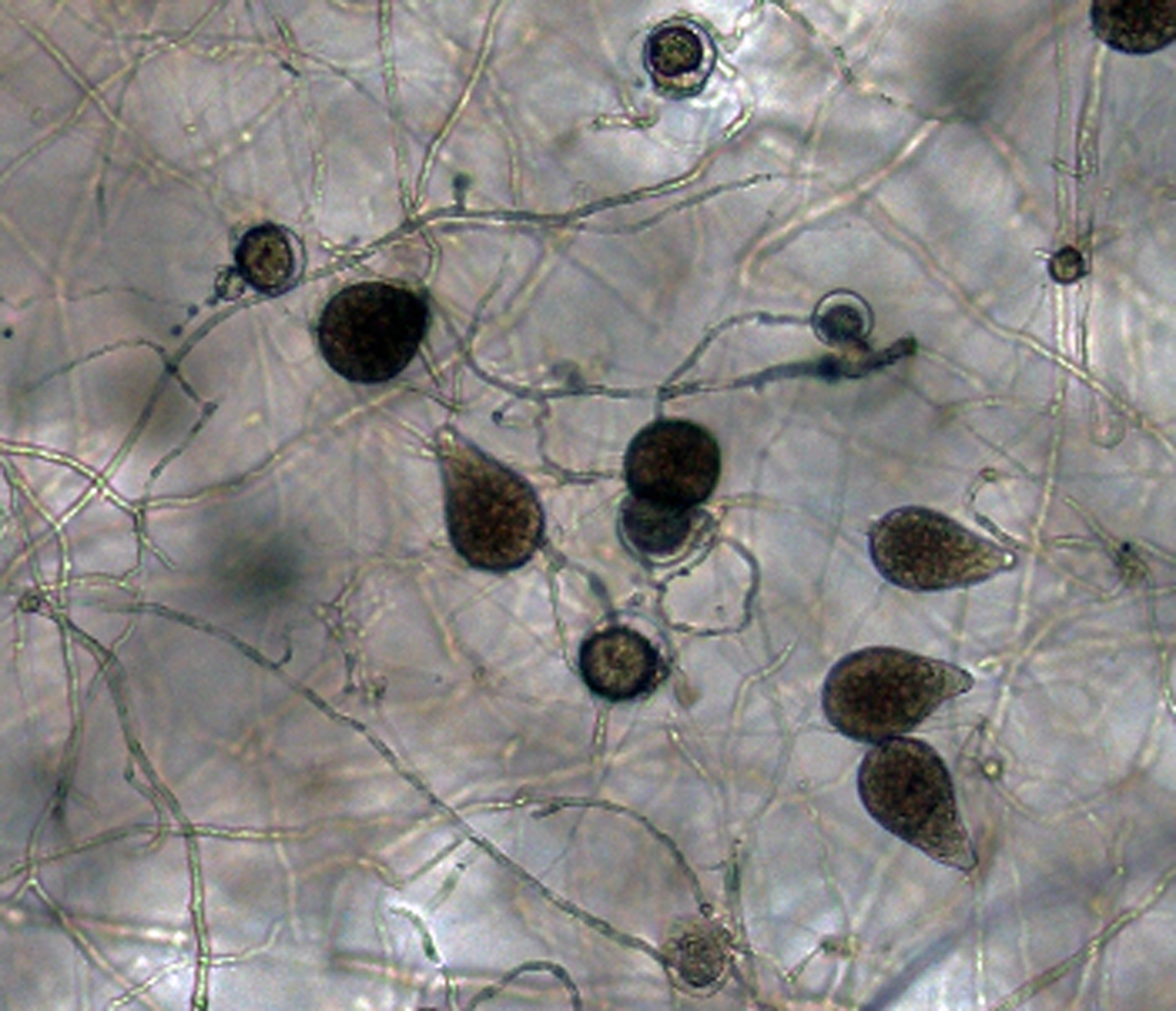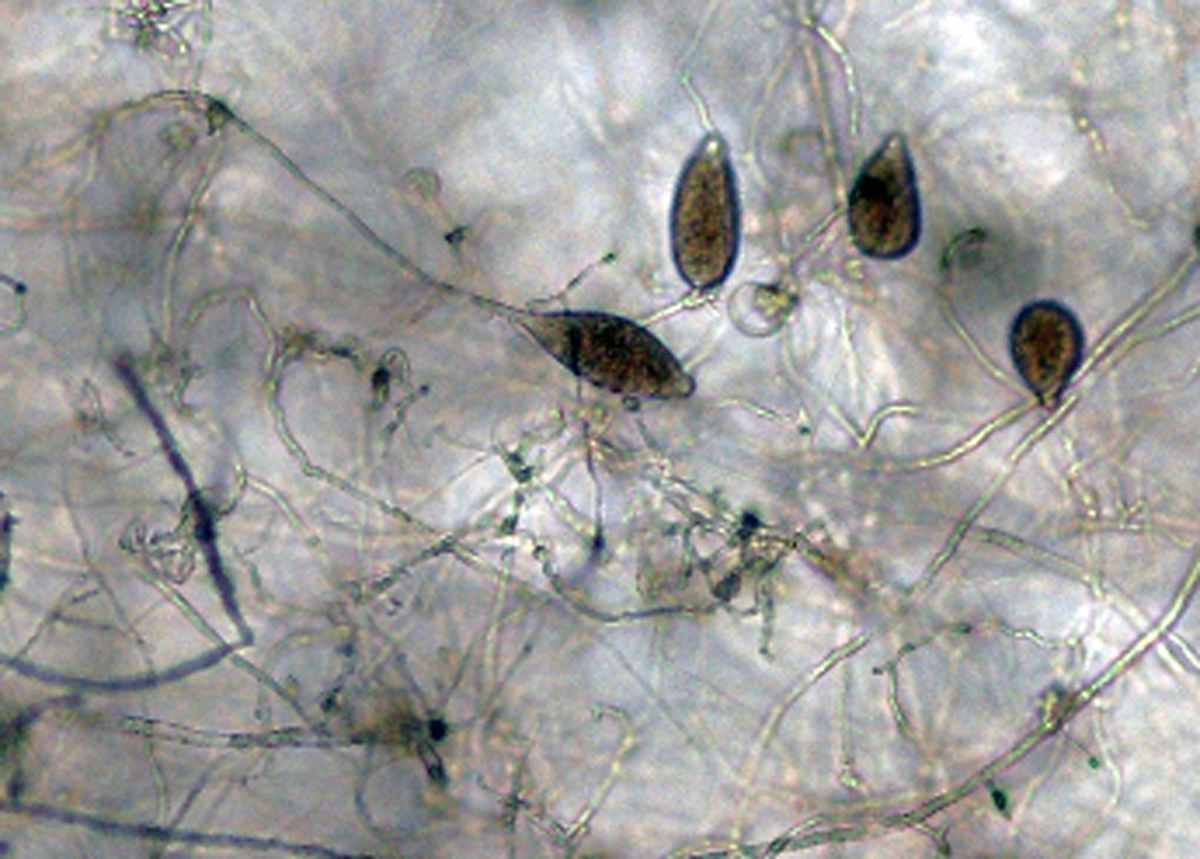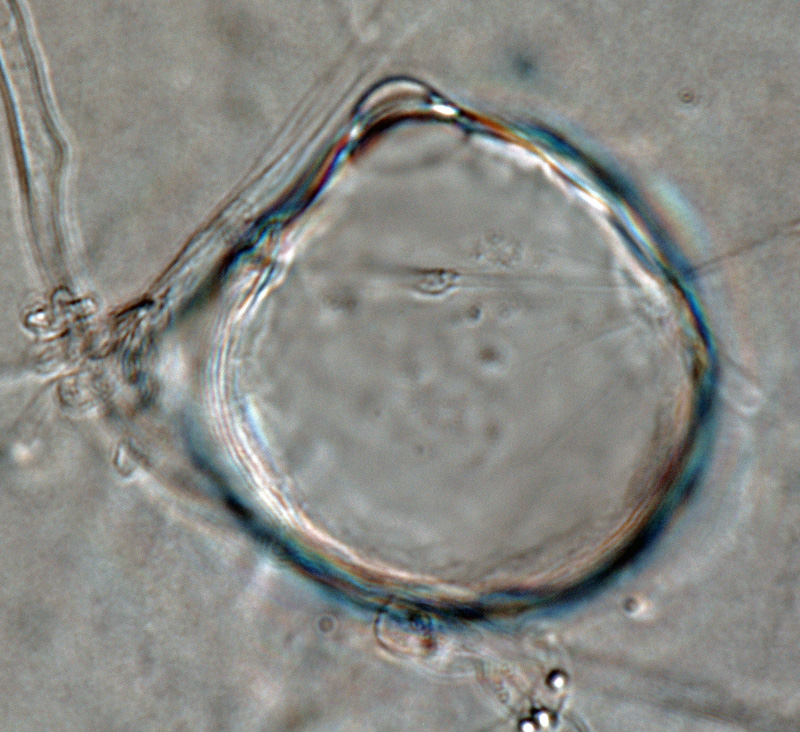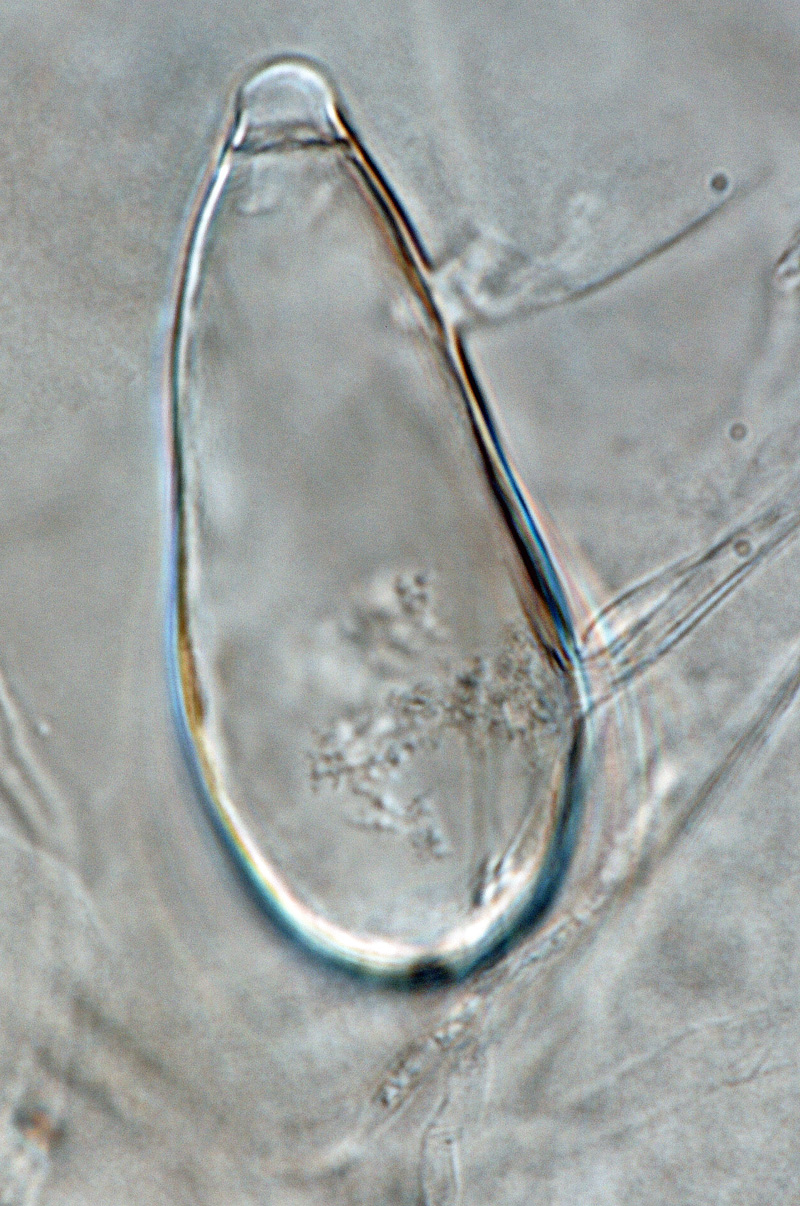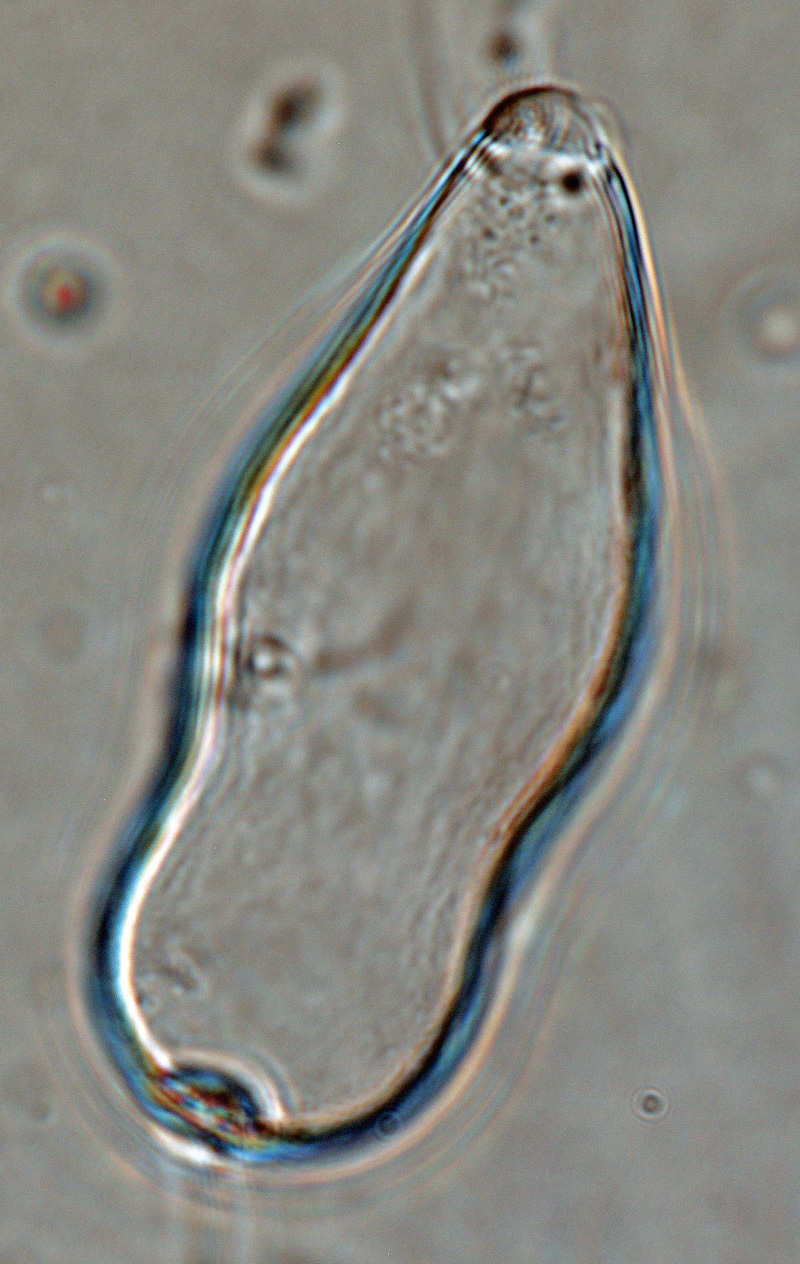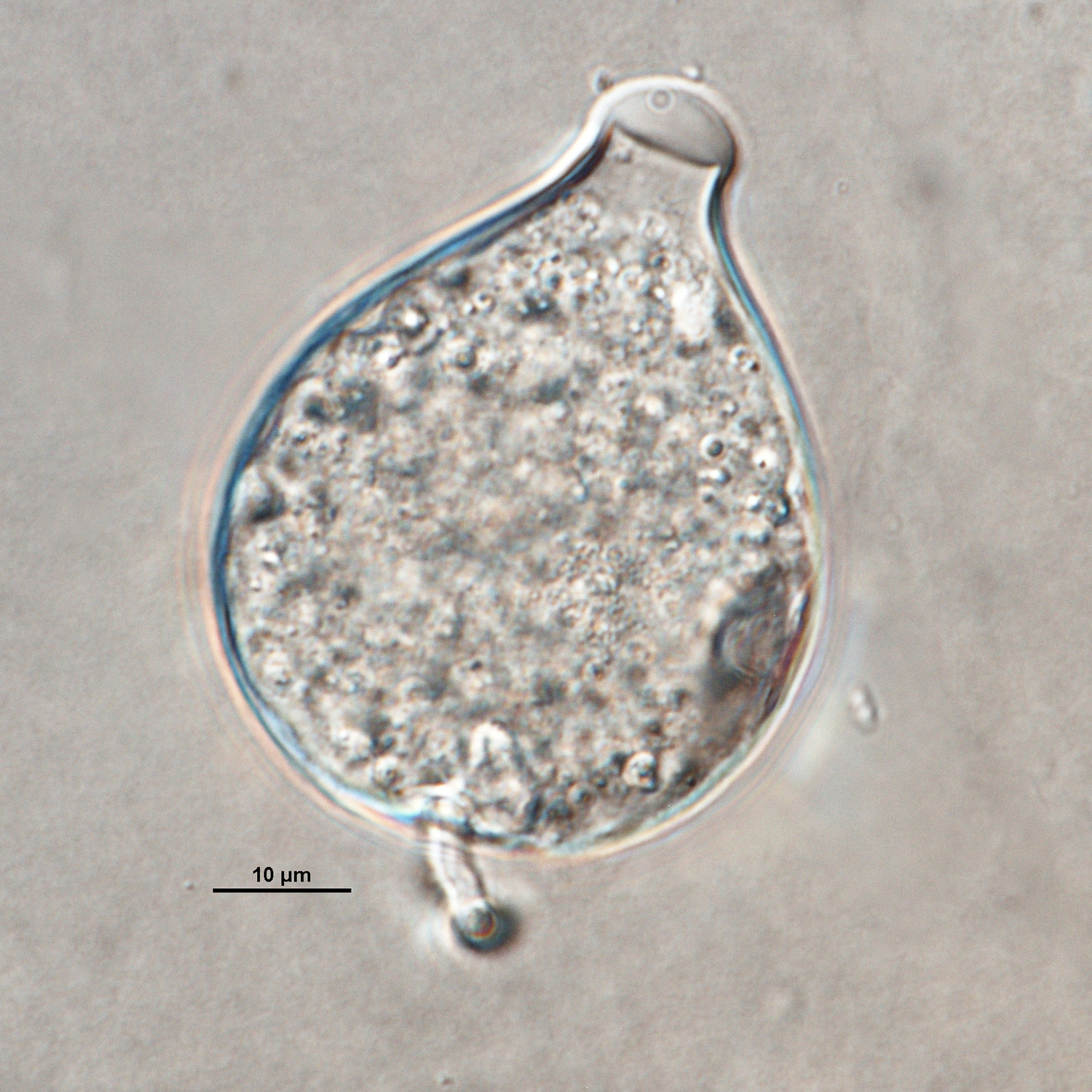Phytophthora iranica
|
Phytophthora spp. in subclade 1b: portion of the seven-loci ML phylogeny featuring the type cultures of 212 described species (by T. Bourret). Notice the position of P. iranica Ex-type CBS 374.72 = S&T BL 40. Gloria Abad, USDA S&T.
|
|
Phytophthora spp. in subclade 1b: Morphological Tabular key (PDF) and Tabular key legends (PDF) in IDphy2 KEY SECTION. Notice the data of P. iranica Ex-type CBS 374.72 = S&T BL 40. Gloria Abad, USDA S&T.
|
|
Phytophthora iranica (CPHST BL 40) colonies of the ex-type grown for 7 days on (a) V8® Agar, (b) potato dextrose agar, and (c) malt extract agar; photo by Krysta Jennings and Leandra Knight, USDA-APHIS-PPQ |
|
Phytophthora iranica (ex-type CPHST BL 40) asexual phase: (a–g) sporangia papillate, mostly persistent but sometimes caducous with medium length pedicel (f), sometimes bipapillate (g) and tripapillate; photos by Gloria Abad, USDA-APHIS-PPQ. |
|
Phytophthora iranica (ex-type CPHST BL 40) sexual phase: (a–h) oogonia smooth-walled and oospores aplerotic; antheridia predominantly paragynous (a–d), sometimes amphyginous (f–h); photos by Gloria Abad, USDA-APHIS-PPQ. |
|
Phytophthora iranica (ex-type CPHST BL 40) sexual phase: oogonium smooth-walled and oospore aplerotic; antheridium predominantly paragynous; photo by Gloria Abad, USDA-APHIS-PPQ. |
|
Phytophthora iranica (ex-type CPHST BL 40) sexual phase: oogonium smooth-walled and oospore aplerotic; antheridium predominantly paragynous; photo by Gloria Abad, USDA-APHIS-PPQ. |
|
Phytophthora iranica (ex-type CPHST BL 40) sexual phase: oogonium smooth-walled and oospore aplerotic; antheridium predominantly paragynous; photo by Gloria Abad, USDA-APHIS-PPQ. |
|
Phytophthora iranica (ex-type CPHST BL 40) sexual phase: oogonium smooth-walled and oospore aplerotic; antheridium predominantly paragynous; photo by Gloria Abad, USDA-APHIS-PPQ. |
|
Phytophthora iranica (ex-type CPHST BL 40) sexual phase: oogonium smooth-walled and oospore aplerotic; sometimes amphyginous antheridium; photos by Gloria Abad, USDA-APHIS-PPQ. |
|
Phytophthora iranica (ex-type CPHST BL 40) sexual phase: oogonium smooth-walled and oospore aplerotic; antheridium predominantly paragynous; photo by Gloria Abad, USDA-APHIS-PPQ. |
|
Phytophthora iranica (ex-type CPHST BL 40) sexual phase: oogonium smooth-walled and oospore aplerotic; sometimes amphyginous antheridium; photos by Gloria Abad, USDA-APHIS-PPQ. |
|
Phytophthora iranica (ex-type CPHST BL 40) sexual phase: oogonium smooth-walled and oospore aplerotic; sometimes amphyginous antheridium; photos by Gloria Abad, USDA-APHIS-PPQ. |
|
Phytophthora iranica (ex-type CPHST BL 40) asexual phase: sporangia papillate, mostly persistent but sometimes caducous; photo by Gloria Abad, USDA-APHIS-PPQ. |
|
Phytophthora iranica (ex-type CPHST BL 40) asexual phase: sporangia papillate, mostly persistent but sometimes caducous; photo by Gloria Abad, USDA-APHIS-PPQ. |
|
Phytophthora iranica (ex-type CPHST BL 40) asexual phase: sporangia sometimes bipapillate and tripapillate; photo by Gloria Abad, USDA-APHIS-PPQ. |
|
Phytophthora iranica (ex-type CPHST BL 40) asexual phase: papillate caducuos sporangium; photo by Gloria Abad, USDA-APHIS-PPQ. |
|
Phytophthora iranica (ex-type CPHST BL 40) asexual phase: papillate caducuos sporangium; photo by Gloria Abad, USDA-APHIS-PPQ. |
|
Phytophthora iranica (ex-type CPHST BL 40) asexual phase: papillate caducuos sporangium; photo by Gloria Abad, USDA-APHIS-PPQ. |
|
Phytophthora iranica (ex-type CPHST BL 40) asexual phase: papillate caducuos sporangium with medium length pedicel; photo by Gloria Abad, USDA-APHIS-PPQ. |
Name and publication
Phytophthora iranica Ershad (1971)
Ershad D. 1971. Beitrag zur Kenntnis der Phytophthora Arten in Iran und ihrer Phytopathlogischen Bedeutung (Contribution to the knowledge of Phytophthora species in Iran and their phytopathogenic importance). Mitt. Biol. Bundesanst. Land Forstwirtsch. Berl. Dahlem 140: 1–90 (pgs 60–64).
Nomenclature
Mycobank
Typification
from Ershad (1971)
Type: IRAN, Varamin, Teheran, from roots of eggplant, aubergine (Solanum melongena) collected in May 1969, D. Ershad CBS H-7642, isolate no. 51
Ex-type: CBS 374.72
Ex-type in other collections
(ET) CBS 374.72, ATCC 60237, CABI IMI158964 (PA), WPC P3882, S&T BL 40 (Abad), 61J4 (Hong), H401
Molecular identification
Voucher sequences for barcoding genes (ITS rDNA and COI) of the ex-type (see Molecular protocols page)
Phytophthora iranica isolate CPHST BL 40 (= P3882 WPC) = ITS rDNA MG865519, COI MH136913
Voucher sequences for Molecular Toolbox with seven genes (ITS, β-tub, COI, EF1α, HSP90, L10, and YPT1
(see Molecular protocols page) (In Progress)
Voucher sequences for Metabarcoding High-throughput Sequencing (HTS) Technologies [Molecular Operational Taxonomic Unit (MOTU)]
(see Molecular protocols page) (In Progress)
Sequences with multiple genes for ex-type in other sources
- NCBI: Phytophthora iranica CPHST BL 40
- NCBI: Phytophthora iranica P3882
- NCBI: Phytophthora iranica CBS 374.72
- EPPO-Q-bank: Phytophthora iranica CBS 374.72
- BOLDSYSTEMS: Phytophthora iranica (barcoding COI & ITS)
Position in multigenic phylogeny with 7 genes (ITS, β-tub, COI, EF1α, HSP90, L10, and YPT1)
Clade 1b
Morphological identification
Colonies and cardinal temperatures
Colony colony:
assemblage of hyphae which usually develops form a single source and grows in a coordinated way
morphology after 7 days of growth on V8 agar with light stellate pattern, on PDA and MEA with no distinct pattern. Minimum temperature for growth is 9°C, optimum 24–30°C, and maximum 33°C.
Conditions for growth and sporulation
Asexual phase
SporangiaSporangia:
sac within which zoospores form, especially when water is cooled to about 10°C below ambient temperature; in solid substrates, sporangia usually germinate by germ tubes
papillatepapillate:
pertaining to the production of a distinct papilla at the distal end of the sporangium (cf. nonpapillate and semipapillate)
, mostly persistentpersistent:
pertaining to sporangia that remain attached to the sporangiophore and do not separate or detach easily (cf. caducous)
but sometimes caducouscaducous:
pertaining to sporangia that become dislodged readily (i.e. deciduous) and separate from the sporangiophore (cf. persistent)
with medium length pedicelpedicel:
the hyphal base of a sporangium that remains attached after the sporangium separates, or is shed, from the sporangiophore; the pedicel may be short (< 5 µm), medium (5–20 µm), or long (> 20 µm)
, sometimes bi- and tripapillate, showing many short radiating hyphaehyphae:
single, tubular filament of a fungal or oomycete thallus; the basic structural unit of a fungus or oomycete
and conspicuous elongated necks; mostly ovoidovoid:
egg-shaped, with the widest part at the base of the sporangium and the narrow part at the apex
or obpyriformobpyriform:
inversely pear-shaped, i.e. with the widest part at the point of attachment (cf. pyriform)
, and occasionally ellipsoidellipsoid:
refers to a solid body that forms an ellipse in the longitudinal plane and a circle in cross section; many fungal spores are ellipsoidal or elliptic
to subspherical (26–87 L x 17–51 W µm); originated in short or long unbranched, or simple sympodial sporangiophores. Hyphal swellings occasionally produced, globoseglobose:
having a rounded form resembling that of a sphere
, subglobose, and radiating. ChlamydosporesChlamydospores:
an asexual spore with a thickened inner wall that is delimited from the mycelium by a septum; may be terminal or intercalary, and survives for long periods in soil
rarely produced (17–41 µm diam), mostly intercalaryintercalary:
positioned within a hypha (cf. terminal)
and rarely terminal.
Sexual phase
Homothallic. Oogonia smooth-walled, subspherical (21–45 µm diam), some with tapered basetapered base:
pertaining to the base of a sporangium or oogonium; funnel-shaped
; antheridiaantheridia:
the male gametangium; a multinucleate, swollen hyphal tip affixed firmly to the wall of the female gametangium (the oogonium)
predominantly paragynousparagynous:
pertaining to the sexual stage in which the antheridium is attached to the side of the oogonium (cf. amphigynous)
, sometimes up to three per oogoniumoogonium:
the female gametangium in which the oospore forms after fertilization by the antheridium
, mostly with cylindrical shape, some with digitate projections; oospores aplerotic aplerotic:
pertaining to a mature oospore that does not fill the oogonium; i.e. there is room left between the oospore wall and oogonium wall (cf. plerotic)
(15–37 µm diam), wall thick (1–5 µm thick).
Specimen(s) evaluated
Phytophthora iranica ex-type CPHST BL 40, duplicate of P3882 (World Phytophthora Collection), which is a duplicate of ex-type CBS 374.72
Hosts and distribution
Distribution: Asia (Iran). Reports from Italy are the new species Phytophthora italica.
Substrate: roots, fruits, tubers
Disease note: root and stem rot, tuber soft rot
Host: Solanum melongena (eggplant); Solanum tuberosum (potato), Solanum lycopersicum (tomato), all Solanaceae, and Beta vulgaris (sugar beet, Chenopodiaceae) are infected when inoculated. Reports on Myrtus (Myrtaceae) are Phytophthora italica.
Retrieved January 31, 2018 from U.S. National Fungus Collections Nomenclature Database.
Additional references and links
- SMML USDA-ARS: Phytophthora iranica
- EPPO Global Database: Phytophthora iranica
- Forest Phytophthoras of the world: Phytophthora iranica
- CABI Digital Library: Phytophthora iranica
- Encyclopedia of Life (EOL): Phytophthora iranica
- Index Fungorum (IF): Phytophthora iranica
- Google All Phytophthora iranica
- Google Images Phytophthora iranica
- Google Scholar Phytophthora iranica
Fact sheet author
Z. Gloria Abad, Ph.D., USDA-APHIS-PPQ-S&T Plant Pathogen Confirmatory Diagnostics Laboratory (PPCDL), United States of America.


